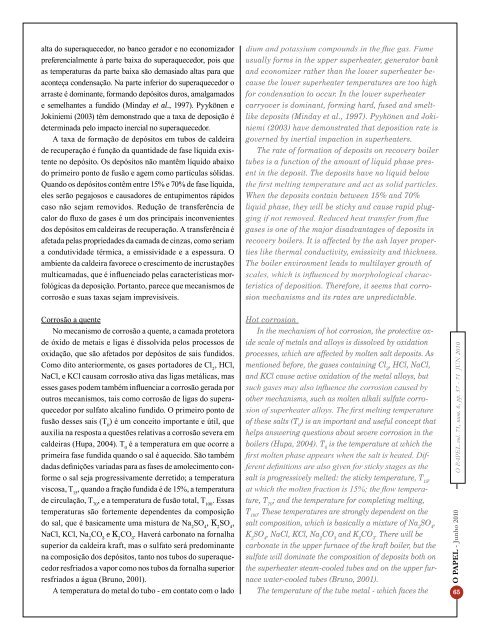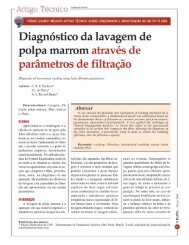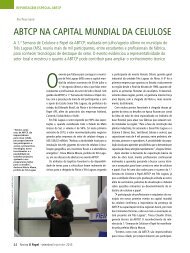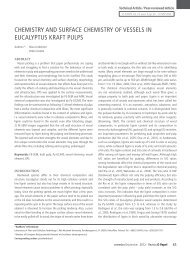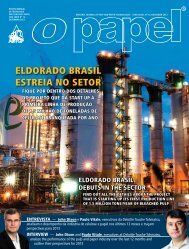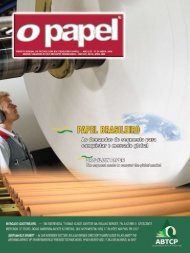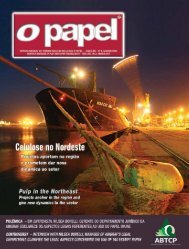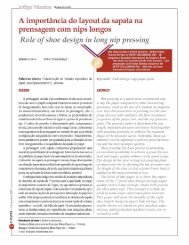Brasil na PulPaper - Revista O Papel
Brasil na PulPaper - Revista O Papel
Brasil na PulPaper - Revista O Papel
You also want an ePaper? Increase the reach of your titles
YUMPU automatically turns print PDFs into web optimized ePapers that Google loves.
alta do superaquecedor, no banco gerador e no economizadorpreferencialmente à parte baixa do superaquecedor, pois queas temperaturas da parte baixa são demasiado altas para queaconteça condensação. Na parte inferior do superaquecedor oarraste é domi<strong>na</strong>nte, formando depósitos duros, amalgamadose semelhantes a fundido (Minday et al., 1997). Pyykönen eJokiniemi (2003) têm demonstrado que a taxa de deposição édetermi<strong>na</strong>da pelo impacto inercial no superaquecedor.A taxa de formação de depósitos em tubos de caldeirade recuperação é função da quantidade de fase líquida existenteno depósito. Os depósitos não mantêm líquido abaixodo primeiro ponto de fusão e agem como partículas sólidas.Quando os depósitos contêm entre 15% e 70% de fase líquida,eles serão pegajosos e causadores de entupimentos rápidoscaso não sejam removidos. Redução de transferência decalor do fluxo de gases é um dos principais inconvenientesdos depósitos em caldeiras de recuperação. A transferência éafetada pelas propriedades da camada de cinzas, como seriama condutividade térmica, a emissividade e a espessura. Oambiente da caldeira favorece o crescimento de incrustaçõesmulticamadas, que é influenciado pelas características morfológicasda deposição. Portanto, parece que mecanismos decorrosão e suas taxas sejam imprevisíveis.dium and potassium compounds in the flue gas. Fumeusually forms in the upper superheater, generator bankand economizer rather than the lower superheater becausethe lower superheater temperatures are too highfor condensation to occur. In the lower superheatercarryover is domi<strong>na</strong>nt, forming hard, fused and smeltlikedeposits (Minday et al., 1997). Pyykönen and Jokiniemi(2003) have demonstrated that deposition rate isgoverned by inertial impaction in superheaters.The rate of formation of deposits on recovery boilertubes is a function of the amount of liquid phase presentin the deposit. The deposits have no liquid belowthe first melting temperature and act as solid particles.When the deposits contain between 15% and 70%liquid phase, they will be sticky and cause rapid pluggingif not removed. Reduced heat transfer from fluegases is one of the major disadvantages of deposits inrecovery boilers. It is affected by the ash layer propertieslike thermal conductivity, emissivity and thickness.The boiler environment leads to multilayer growth ofscales, which is influenced by morphological characteristicsof deposition. Therefore, it seems that corrosionmechanisms and its rates are unpredictable.Corrosão a quenteNo mecanismo de corrosão a quente, a camada protetorade óxido de metais e ligas é dissolvida pelos processos deoxidação, que são afetados por depósitos de sais fundidos.Como dito anteriormente, os gases portadores de Cl 2, HCl,NaCl, e KCl causam corrosão ativa das ligas metálicas, masesses gases podem também influenciar a corrosão gerada poroutros mecanismos, tais como corrosão de ligas do superaquecedorpor sulfato alcalino fundido. O primeiro ponto defusão desses sais (T 0) é um conceito importante e útil, queauxilia <strong>na</strong> resposta a questões relativas a corrosão severa emcaldeiras (Hupa, 2004). T 0é a temperatura em que ocorre aprimeira fase fundida quando o sal é aquecido. São tambémdadas definições variadas para as fases de amolecimento conformeo sal seja progressivamente derretido; a temperaturaviscosa, T 15, quando a fração fundida é de 15%, a temperaturade circulação, T 70, e a temperatura de fusão total, T 100. Essastemperaturas são fortemente dependentes da composiçãodo sal, que é basicamente uma mistura de Na 2SO 4, K 2SO 4,NaCl, KCl, Na 2CO 3e K 2CO 3. Haverá carbo<strong>na</strong>to <strong>na</strong> for<strong>na</strong>lhasuperior da caldeira kraft, mas o sulfato será predomi<strong>na</strong>nte<strong>na</strong> composição dos depósitos, tanto nos tubos do superaquecedorresfriados a vapor como nos tubos da for<strong>na</strong>lha superiorresfriados a água (Bruno, 2001).A temperatura do metal do tubo - em contato com o ladoHot corrosionIn the mechanism of hot corrosion, the protective oxidescale of metals and alloys is dissolved by oxidationprocesses, which are affected by molten salt deposits. Asmentioned before, the gases containing Cl 2, HCl, NaCl,and KCl cause active oxidation of the metal alloys, butsuch gases may also influence the corrosion caused byother mechanisms, such as molten alkali sulfate corrosionof superheater alloys. The first melting temperatureof these salts (T 0) is an important and useful concept thathelps answering questions about severe corrosion in theboilers (Hupa, 2004). T 0is the temperature at which thefirst molten phase appears when the salt is heated. Differentdefinitions are also given for sticky stages as thesalt is progressively melted: the sticky temperature, T 15,at which the molten fraction is 15%; the flow temperature,T 70; and the temperature for completing melting,T 100. These temperatures are strongly dependent on thesalt composition, which is basically a mixture of Na 2SO 4,K 2SO 4, NaCl, KCl, Na 2CO 3and K 2CO 3. There will becarbo<strong>na</strong>te in the upper fur<strong>na</strong>ce of the kraft boiler, but thesulfate will domi<strong>na</strong>te the composition of deposits both onthe superheater steam-cooled tubes and on the upper fur<strong>na</strong>cewater-cooled tubes (Bruno, 2001).The temperature of the tube metal - which faces theO PAPEL - Junho 2010 O PAPEL vol. 71, num. 6, pp. 57 - 71 JUN 201065


